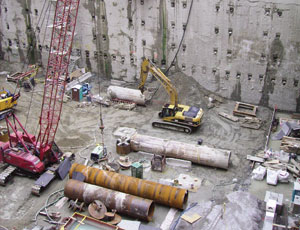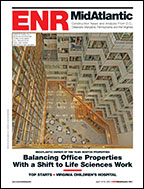In order to build a new clinical facility for cancer patients on a tight Boston site, engineers and contractors had to devise a 70-ft-to 110-ft-deep barrier wall to serve double duty by cutting off groundwater and isolating ground vibration. They did that by installing a rock-socketed 3-ft-thick slurry wall incorporating 268 permanent tieback anchors, many located under a busy city street, and by cantilevering a lay-down area.

The $350-million Yawkey Center for Cancer Care is the latest addition to the Dana-Farber Cancer Institute (DFCI). The 15-story structure is being built on a 198-ft-by-186-ft site and will have seven levels of below-grade parking. But the Yawkey Center had to be shoehorned between the 100,000-sq-ft footprint of the Medical Area Total Energy Plant (MATEP), the 13-story Smith Building research laboratory with its seven levels of below-grade parking, busy Brookline Avenue and Jimmy Fund Way. “Yawkey Center will allow DFCI to address a significant increase in patient visits as well as expected growth in patient volume well into the next decade,” says Thomas F. Herring, DFCI project executive.
A low-vibration hydromill was used to cut through rock to install the slurry wall and avoid disrupting nearby structures. But hydromill vibration was a small issue. The 30-year-old MATEP provides peaking power for 9 million sq ft of occupied space using six 32-cylinder foundation-mounted diesel-engine/generator sets. They also produce 10 Hz of low- frequency ground vibration. “The 10 Hz is a problem since it closely matches the natural frequency of many building elements,” says Alan H. Simon, president of Simon Design Engineering LLC, Wellesley, Mass., project structural engineer. “If the generating frequency matches the natural frequency, the vibrations will be amplified considerably into the feelable and noticeable range, which will affect research and patient comfort.” Foundations for the Yawkey Center will rest on 40 concrete footings and piers, including 6-ft-dia. drilled shafts and varying sizes of rectangular piers installed in sheeted pits. To further dampen vibrations, the piers are surrounded by a 2-in.-thick layer of closed-cell polyethylene isolation foam. The garage and building foundation will be built 10 ft inside the slurry walls.
“The superstructure is freestanding. It sits on columns bearing on bedrock without touching the perimeter slurry walls,” says David R. Shields, senior consultant, GEI Consultants Inc., Woburn, Mass., the geotechnical engineer. On the Brookline Avenue side, perimeter columns are bent 7.9 degrees. “Columns were offset to maintain vibration isolation and avoid digging foundations near the toe of the slurry wall,” says Simon. The soils consist of clay and fine sand, and the foundation is about 90 ft below the groundwater table. The tiebacks, 225 kips to 780 kips, were waterproofed using threaded collars and a water swelling cap. “One of the biggest challenges was installing tiebacks into the sand without having the sand flow into the excavation,” says Shields. “This was done by using a drilling collar to create a seal between the drill casing and the wall.”
On the Brookline Avenue side, a 180-ft-long, 35-ft-wide lay-down area was created by roofing over a portion of the parking garage. Cantilevering a cast-in-place concrete beam into the slurry wall created another 170-ft-long, 15-ft-wide area on Jimmy Fund Way. “It was formed and cast monolithically to the top of the slurry wall after the initial excavation,” says Shields. “Both areas are critical because there was no other access to the site.” The project, which started in late 2005, is scheduled for an early 2011 completion.


Post a comment to this article
Report Abusive Comment